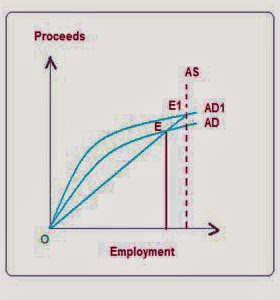Introduction
The logical starting point of Keynes’s theory of employment is the principle of
effective demand. In a entrepreneurial economy, the level of employment is
based on effective demand. Thus employment results from a deficiency of
effective demand and the level of employment can be raised by increasing the
level of effective demand.
Aggregate
Demand Price
“The aggregate demand price for the output of any given amount of employment is
the total sum of money or proceeds which is expected from the sale of the
output produced when that amount of labor is employed.” Thus the aggregate
demand price is the amount of money which the entrepreneurs expect to get by
selling the output produced by the number of men employed. In other words it
refers to the expected revenue from the sale of output produced at a particular
level of employment. Different aggregate demand prices relate to different
levels of employment in the economy.
A statement showing the various aggregate demand prices at different levels of
employment is called the aggregate demand price schedule or aggregate demand
function. “The aggregate demand function.” according to Keynes, “relates any
given level of employment to the expected proceeds from that level of
employment.”
The below tablet represents the aggregate demand schedule where it reveals
that, with the increase in the level of employment proceeds, expected rise and
at lower levels of employment decline. When 900 thousand people are provided
employment the aggregate demand price is $560 million and when 250 thousand
people are provided jobs, it is $480 million.
According to Keynes the aggregate demand function is an increasing function of
the level of employment and is expressed as D = F (N), where D is the proceeds
which entrepreneurs expect from the employment of N men.
Level of Employment
In 100 thousands |
Aggregate Demand Price (D)
In Million $ |
4
|
460
|
5
|
|
6
|
500
|
7
|
520
|
8
|
540
|
9
|
560
|
10
|
580
|
When an entrepreneur gives employment to a definite amount of labor, it
requires certain quantities of co-operant factors like land, capital, raw
materials etc. which will be paid remuneration along with labor. Thus each
level of employment involves certain money costs of production including normal
profits which the entrepreneur must cover. “At any given level of employment of
labor aggregate supply price is the total amount of money which all the
entrepreneurs in the economy, taken together must expect to receive from the
sale of the output produced by that given number of men, if it is to be just
worth employing them.”
In brief, the aggregate supply price refers to the proceeds necessary from the
sale of output at a particular level of employment. Thus each level of
employment in the economy is related to a particular aggregate supply price and
these are different aggregate supply prices for different levels of employment.
A statement showing the various aggregate supply prices at different levels of
employment is called aggregate supply price schedule or aggregate supply
function. In the words of Prof. Dillard, “The aggregate supply function is a
schedule of the minimum amounts of proceeds required to induce varying
quantities of employment.” The below tablet reveals the aggregate supply schedule,
Level of Employment (N)
in 100 Thousands |
Aggregate Supply Prize (Z)
In Million $ |
4
|
430
|
5
|
460
|
6
|
490
|
7
|
520
|
8
|
550
|
9
|
580
|
10
|
610
|
The above table reveals that the aggregate supply prices rise with the hike in the level of employment. If entrepreneurs are to provide employment to 400 thousand workers, they must receive $430 millions from the sale of output produced by them. It is only when they expect to receive minimum amounts of proceeds ($460 millions, $490 million and $520 million) that they will provide employment to more workers (5, 6 and 7 hundred thousand dollars respectively).
But when the economy reaches the level of full employment (at 800 thousand
workers, the aggregate supply price ($550 million, $580 million and $610
millions) continues to increase but there is no further is an increasing
function of the level of employment and is expressed as Z = ɸ
N, Z is the aggregate supply price of the output level from employing N men.
The aggregate supply curve can be drawn on the basis of the schedule. It
inclines upward from left ro right for the reason that the necessary expected
proceeds hikes; the level of employment also rises. But when the economy
reaches the level of full employment, the aggregate supply curve becomes
vertical. Even with the hike in the aggregate supply price, it is not possible
to provide more employment as the economy has attained the level of full
employment.


No comments:
Post a Comment